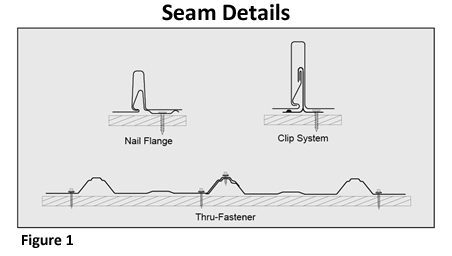Making The Case For Using 26-Gauge Steel For Residential Roofs
By Peter Tuininga, The Bryer Company, Inc.
Let’s talk about gauge selection. A common question, especially in the residential roofing market is, what thickness of steel should my metal roof be? This is a seemingly basic question with a difficult and nuanced answer. There are a multitude
of factors to consider, so let’s break them down.
Generally speaking, single-family homes have historically used 26-gauge (minimum .0187” thick steel) for standing seam profiles and 29-gauge (minimum .0142” thick) for a more economical thru-fastened application. For new construction, the
vast majority of single-family homes incorporate a solid substrate, usually plywood or OSB sheathing. For this reason, a panel's structural performance as it relates to spanning open-framed substrates and live loads is not a factor.
So why 26-gauge for one type of profile and 29 gauge for a different type? For the most part, the answer lies in how the panel is attached to the substrate and how they lap together across the roof. With a thru-fastened roof, the panel is mechanically
attached using exposed screws that penetrate through the roof panel and into the wood substructure. The laps, where adjoining panels come together, are secured with a stitch screw that holds or stiches (hence the name) the two overlapping pieces of
metal. As such, the roof system’s relative strength as it relates to wind resistance is a factor of the fasteners pull-out strength.
Standing seam panels are a different breed, especially snap seam profiles. Snap seam panels rely on the engagement of what are commonly referred to as the male and female ribs. More specifically, the female side of the panel fits down and “snaps”
into place over the male side. This type of system relies more directly on the strength of the steel itself to hold the seam together while under load. Standing seam panels are still held to the substructure with fasteners, either in conjunction with
a separate concealed clip, or through an integrated fasting flange (figure 1).
 Either way, negative wind loads (ie. uplift pressure) can cause significant strain on the panel seam itself and, for this reason, it is rare to see standing seam profiles
produced in steel thinner than 26-gauge.
Either way, negative wind loads (ie. uplift pressure) can cause significant strain on the panel seam itself and, for this reason, it is rare to see standing seam profiles
produced in steel thinner than 26-gauge.
Of course, wind resistance is not the only factor to consider. Resistance to foot traffic and other types of blunt force damage should be considered. Standing seam panels are relatively flat to the deck with the exception of the seam. As long as some
care is taken to avoid these seams when walking on the roof it is unlikely that foot traffic during install, maintenance, cleaning, etc., would do any significant damage.
Keep in mind that I’m not including cosmetic damage, but when talking about scratches from foot traffic or overspray from the painters, gauge does not make a difference. Most thru-fastened roofs have ribs formed across the entire width of the panel.
If using 29-gauge, a 200 lb. man could easily crush a rib standing directly on top of it. A 29-gauge panel is also much more susceptible to kinks, dings and creases caused during handling and install, especially when dealing with longer lengths, and
so it’s not uncommon to see 26-gauge used for thru-fastened profiles. That said, if reasonable care is taken then even a 29-gauge roof can be installed without significant damage. Debris in the form of large broken branches or concerns over
large hail can also play a role in making a gauge determination.
So, if 29-gauge is good and 26-gauge is better, does that mean 24-gauge is the best option when choosing a residential standing seam panel? Maybe, but what do you get in return for the added cost? In our region [the Pacific Northwest] many high-quality,
reputable residential contactors, have decided to only offer 24-gauge, with 26-gauge not even presented as an option. While there is little doubt that the thicker steel does provide a better overall system, the question of return on investment remains.
Since Bryer added a residential division in 2020 I have been extremely surprised by the fact that 24-gauge outsells 26-gauge in our market for residential standing seam projects, even in economical nail-flange systems. I would argue that, in the vast
majority of applications, and assuming everything else is equal (PVDF paint system, AZ50 Galvalume coated steel, solid substrate, etc.), most home owners will never realize significant additional value by spending the extra money on the more “commercial”
24-gauge.
A properly installed 26-gauge standing seam roof will typically outlive the homeowner in all but the most severe environments (think corrosive coastal/marine regions). A quality 26-gauge standing seam panel also meets all of the recognized UL ratings
for wind uplift, fire and impact (hail) resistance. If there are mitigating circumstances where the added strength is critical then, by all means, 24-gauge may be your best option. However, in my opinion, spending additional resources on the installation
and ensuring you hire a highly competent sheet metal roofing contractor is a much more important “upgrade” for the homeowner when compared to a roof panel that is only 0.005” thicker.
Bryer happily sells residential 24-gauge metal roof systems every day, and we do so knowing the homeowner is getting an outstanding system that will protect their home for decades. My real concern lies with the homeowner that loves the idea of a metal
roof; life-cycle cost, energy efficiency, durability, eco-friendliness and overall beauty, but is priced out of that option by only getting 24-gauge bids. In many cases, a 26-gauge system may have fallen within budget and still offered all the same
advantages over competing roof systems.
We can’t have a discussion on gauge without considering the dreaded oil-canning topic. The Metal Construction Association defines oil-canning as a perceived waviness in the flat areas of metal roofing and siding panels. This can be caused by a multitude
of factors, one of them being steel gauge. The effect is purely aesthetic and has no impact on the performance or long-term durability of the system. Oil-canning is a complex and tricky subject, so I will save that deep dive for another discussion.
But keep in mind that no manufacturer will guarantee they can eliminate oil-canning simply by going from 26 to 24-gauge, or even 22-gauge for that matter. There are plenty of examples of absolutely great looking 26-gauge roofs with zero oil-canning
and just as many 24 and 22-gauge roofs that have terrible oil-canning.
So, if 26-gauge is typically adequate, why do so many commercial jobs use heavier gauges? Commercial construction regularly places added demands on the exterior envelope, so panel gauge can be a factor on multiple fronts. The wear and tear a commercial
building can see will usually exceed that of a single-family home. Ongoing maintenance on the roof, including roof mounted equipment is typical. Wall panels can also see a lot more abuse; think elementary school playground areas or retail store entrances.
Open framing, meaning the exterior panel is spanning sub-structural support members without a solid substrate, can end up dictating a minimum gauge to meet load requirements.
Speaking of loads, wind uplift will oftentimes play a much larger role in gauge selection on commercial projects. Take for example a hospital or school. These types of structures include code requirements that dictate they must be built to a higher standard
in order to withstand potentially more devastating storms.
These types of requirements will often mandate the use of heavier gauges and stronger panel systems in order to meet wind uplift engineering.
That said, there are countless commercial projects that specify 22-gauge, seemingly because it is perceived to be a better system. In the absence of specific load requirements, the same argument made for 26-gauge vs 24-gauge in residential construction
could also be made for 24-gauge vs 22-gauge in commercial. A 24-gauge commercial standing seam system is extremely strong, extremely durable and would be expected to give a 50+ year service life in most applications. How often is 22-gauge specified
on a project where 24-gauge would perform just as well?
My plea to the residential contractor who has stopped offering 26-gauge standing seam systems is to reconsider. If you have a budget conscious homeowner interested in metal but without the ability to upgrade to 24-gauge, then give them a 26-gauge option
knowing that, if properly installed, it will still be far superior to most other roofing options on the market.
I would love to hear feedback on this issue, especially from those residential roofers only offering 24 gauge. What are your thoughts, does a 26-gauge standing seam panel still provide a high quality roof system?
About The Author
Peter Tuininga is Vice President at The Bryer Company, Inc. located in Auburn, Washington. Founded in 1985, Bryer is a regional component panel manufacturer that serves the architectural, commercial and residential metal roof and wall panel markets. Tuininga
has held various rolls in the metal roofing industry over a 25-year career and currently oversees production, sales and marketing at Bryer. He can be reached at ptuininga@thebryercompany.com. For more information on Bryer, visit www.thebryercompany.com.
About The Bryer Company
 Founded in 1985, Bryer is a regional component panel manufacturer that serves the architectural, commercial and residential metal roof, wall and soffit panel markets.
Founded in 1985, Bryer is a regional component panel manufacturer that serves the architectural, commercial and residential metal roof, wall and soffit panel markets.
From its manufacturing plant in Auburn, Wash., Bryer provides the construction industry with top-of-the-line standing seam roof panels, concealed-fastener wall panels, traditional thru-fastened profiles, perforated panels, flat sheet and coil, as well as a broad line of related accessories - including fasteners, sealants, foam closures, flashing and roof top attachment solutions.
Above all else, Bryer continually strives to lead the industry with outstanding service and quality. For more information, call 888-462-7937 or visit www.thebryercompany.com.